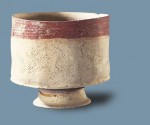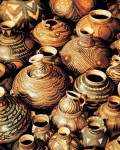Decorative patterns on painted portery of the Yangshao culture
 Painted pottery of the Yangshao culture is recognized as the most representative of the prehistory painted pottery found in China.
Painted pottery of the Yangshao culture is recognized as the most representative of the prehistory painted pottery found in China.
Back in 1921, ruins of a primitive village were found at Yangshao Village, Mianchi County, Henan Province, which was to be identified as belonging to a highly developed matriarchal society existed in central China.
Many cultural relics have been unearthed from the site since then. Included are pottery utensils for daily use, which are valued not only for their cultural importance but also for the workmanship with which they were produced. Earth to be used for making the roughcasts with was rinsed and, for that, most products are of the same color as their roughcasts. To be more precise, products produced with roughcasts of fine mud are red, and those produced with roughcasts of fine mud mixed with fine grains of sand are brownish red.
Most decorative patterns were painted in black, and the rest in red.  Sometimes a thin layer of red or white coating was applied to the roughcasts, on which decorative patterns were then painted, in order to ensure a greater contrast of the colors.
Sometimes a thin layer of red or white coating was applied to the roughcasts, on which decorative patterns were then painted, in order to ensure a greater contrast of the colors.
The Yangshao culture dates back to a period from 5,000 years BC to 3,000 years BC. Primitive sites and ruins found later in other parts of central China are culturally similar to the Yangshao ruins. For that, the Yangshao culture has been recognized as synonym of the culture prevalent in central China during the matriarchal clan society – in a region with Gansu, Shaanxi and Henan as center while encompassing Hebei, Inner Mongolia, Shanxi, Qinghai, as well as parts of Hubei.